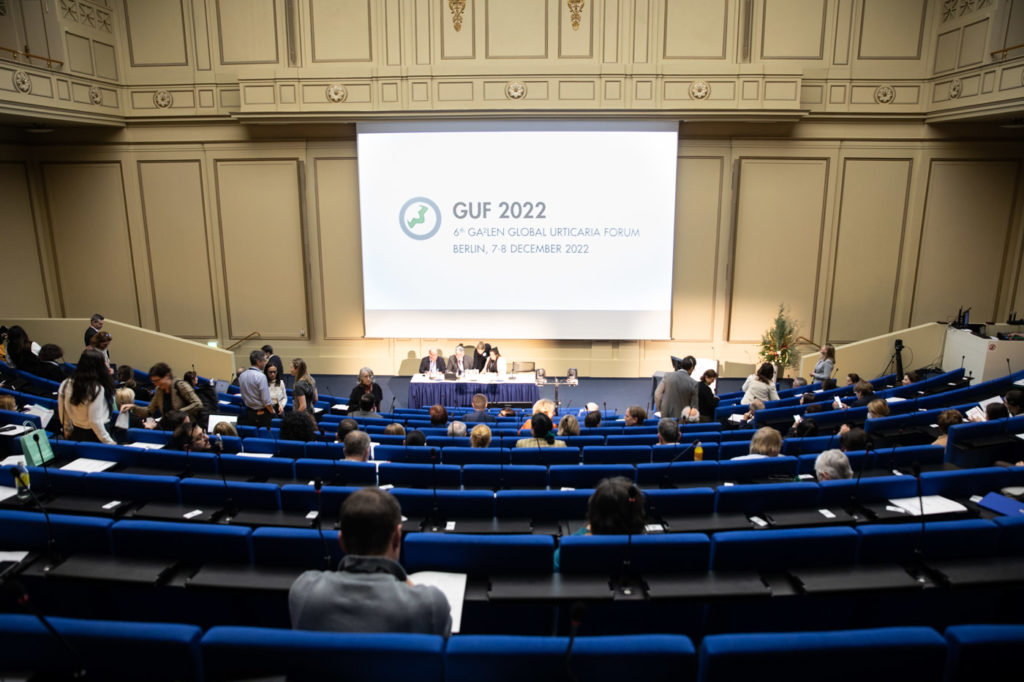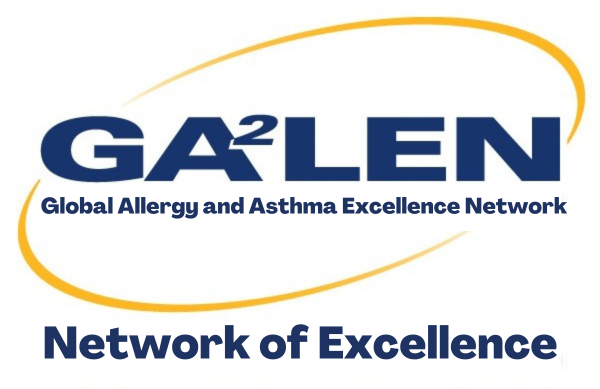Preliminery Scientific Programme
by October 2024
Wednesday, 4 December 2024
08:00-09:45
Registration
09:45-10:00
Welcome, introduction and objectives
Ana Giménez-Arnau, Torsten Zuberbier , Emek Kocatürk, Luis Ensina
Keynote lecture session I: Pathophysiology of CSU:
10:00-10:25
Chronic spontaneous urticaria: Update on pathophysiology
Sarbjit Saini and Michihiro Hide
10:25-10:50
Non-IgE-mediators and neurogenic activation of mast cells
Martin Metz and Young Min Ye
Oral presentation session I: Aetiopathogenesis of urticaria, differential diagnosis, comorbidities and diagnostic approaches
10:50-10:59
10:59-11:08
11:08-11:17
11:17-11:26
11:26-11:35
OP. 001 | The role of T-cell-mast-cell cross talk and proximity in the pathogenesis of chronic spontaneous urticaia
Elias Toubi
OP. 002 | Relevance of the basophil activation test in a cohort of 240 patients with chronic spontaneous urticaria
David Pesqué
OP. 003 | Development of a rapid and portable test for the measurement of anti-TPO IgE in clinical practice. Proof of concept.
Jorge Sanchez
OP. 004 | Depletion of mast cells with barzolvolimab, an anti-KIT antibody, does not affect mast cell progenitor numbers or function
Sherezade Moñino-Romero
OP. 005 | CD300 receptor: A new target in the pathogenesis of autoimmune urticaria?
Ozge Sevil Karstarli Bakay
11:36-12:00
Coffee break
EMBRN session: The biology of mast cells and basophils and their role in health and disease
12:00-12:05
EMBRN introduction
Frank Siebenhaar and Francesca Levi-Schaffer
12:05-12:20
The evolving story of the allergic effector unit
Francesca Levi-Schaffer
12:20-12:35
Mast cells and tissue infiltrating immune cells
Stefan Frischbutter
12:35-12:50
Mast cells in the skin: enemies driving inflammation or defenders of integrity?
Anne Dudeck
12:50-12:55
Summary
Frank Siebenhaar and Francesca Levi-Schaffer
12:55-13:55
Sponsored Symposium
13:55-14:25
Lunch break
Keynote lecture session II: Endotypes and biomarkers of CU
14:25-14:50
Endotypes of CSU – What we know and what we don´t know
Pavel Kolkhir and Riccardo Asero
14:50-15:15
Biomarkers of CU clinical behavior and therapy response to available treatments
Desire Larena Linnemann and Luis Ensina
Oral presentation session II: Urticaria treatments, predictors of response and biomarkers in CU
15:15-15:24
15:24-15:33
15:33-15:42
15:42-15:51
15:51-16:00
OP. 006 | EVO756, an oral MRGPRX2 antagonist, is well-tolerated and demonstrates target engagement: Topline results from a phase 1 study
Sarbjit S. Saini
OP. 007 | Prognostic value of novel in-vitro variables for severe CSU responding and not responding to omalizumab
Riccardo Asero
OP. 008 | Barzolvolimab shows profound efficacy and favorable safety over 52 weeks in patients with chronic spontaneous urticaria
Martin Metz
OP. 009 | Rilzabrutinib reduces severity of weekly urticaria activity score in patients with chronic spontaneous urticaria in RILECSU phase 2 trial
Ana Maria Giménez-Arnau
OP. 010 | Safety and efficacy of remibrutinib in japanese patients with chronic spontaneous urticaria (BISCUIT study interim analysis)
Koremasa Hayama
14:49-14:58
OP.007 PREDICT-CU: Predicting time to clinical remission in chronic urticaria
Maria-Magdalena Balp (Switzerland)
14:07-15:16
OP.009 Urticaria in patients with suspected mast cell activation syndrome
Fabiana Nunes Oliveira (Brazil)
14:58-15:07
OP.008 Remibrutinib inhibits mastcell and basophil activation in chronic urticaria independently of FcεR1 expression
Ana Giménez-Arnau (Spain)
14:16-15:25
OP.010 In chronic spontaneous urticaria, fever, pain and malaise are common and linked to active and uncontrolled disease: Results from the Chronic Urticaria Registry (CURE)
Polina Pyatilova (Germany)
16:02-16:35
Coffee break
Poster walks and poster session
16:35-17:35
Poster walks and poster session
In recognition of the great person, Marcus Maurer.
17:35-18:35
The history of modern urticaria and a tribute to Marcus Maurer
Oral Presentation Session III: Urticaria treatments and predictors of response
16:20-16:40
What’s new?
16:40-17:25
Oral Presentations
17:49-17:58
OP.012 Long-term safety of remibrutinib in CSU patients: Phase 2b study
Ana Giménez-Arnau (Spain)
17:58-18:07
OP.013 Dupilumab Efficacy in Patients with Chronic Spontaneous Urticaria with Comorbidities
Marcus Maurer (Germany)
18:07-18:16
OP.014 Cold urticaria patients achieve complete response with 1.5 mg/kg barzolvolimab
Dorothea Terhorst-Molawi (USA)
18:16-18:25
OP.015 Elevated levels of soluble FcεRI as a biomarker of early and good response to omalizumab treatment in chronic spontaneous urticaria
Sherezade Moñino-Romero (Germany)
18:25-18:34
OP.016 Differences between pediatric and adult urticaria: patient characteristics, treatment response and indicators of response
Sinem Ornek Ozdemir (Turkey)
18:34-18:43
OP.017 Autoimmunity and low IgE in CSU: a prospective analysis
David Pesqué (Spain)
18:43-18:52
OP.018 Anti-TPO/total IgE ratio – biomarker for omalizumab response prediction in CSU
Rita Brás (Portugal)
18:35
Scientific Dinner
Thursday, 5 December 2024
07:15-08:30
Registration
08:30-08:35
Welcome and summary day 1
Torsten Zuberbier (Germany)
UCARE session
08:35-09:05
UCARE update
09:05-09:38
Current UCARE scientific projects
09:38-09:56
Upcoming projects
14:48-15:01
Importance of the complement test in patients with angioedema taking ACE inhibitor
Henriette Farkas (Hungary)
15:01-15:14
The use of anti-IgE therapy to define idiopathic non-histaminergic angioedema
Jason Fok (Australia)
15:14-15:27
Estrogen triggering non-hereditary Angioedema
Anete Grumach (Brazil)
15:27-15:40
ACARE projects and activities
Markus Magerl (Germany)
Oral presentation session III: Urticariological highlights
09:56-10:41
09:56-10:41
09:56-10:41
09:56-10:41
09:56-10:41
OP. 011 | Efficacy and safety of dupilumab in chronic spontaneous urticaria – An exploratory phase 2 investigator-initiated trial
Martin Metz
OP. 012 | Efficacy, predictors of response and safety of H1 AH in the treatment of CU in children
Larissa Brandão
OP. 013 | Differential susceptibility of hair color changes after anti-KIT antibody, barzolvolimab in patients with chronic inducible urticaria
Melba Munoz
OP. 014 | Evaluation of disease severity metrics in pediatric patients with chronic spontaneous urticaria
Moshe Ben Shoshan
OP. 015 | Urticaria and its shadows: What to measure beyond the skin
Ivan Cherrez-Ojeda
09:14-09:23
OP.020 Treatment with MRGPRX2 Antagonist EP262 Potently Inhibits Mast Cell Degranulation
Veena Viswanath (USA)
09:23-09:32
OP.021 Remibrutinib improves CSU in patients with low or high IgE
Michihiro Hide (Japan)
09:32-09:41
OP.022 Anti-IL-23 treatment in patients with omalizumab-refractory chronic spontaneous urticaria – a case series
Hanna Bonnekoh (Germany)
09:41-09:50
OP.023 Omalizumab drug survival for chronic urticaria – the DruSO-CU UCARE study
Reineke Soegiharto (The Netherlands)
09:50-09:59
OP.024 CRUSE – What the first 100 days have taught us
Sophia Neisinger (Germany)
10:41-11:10
Coffee Break
ACARE session: Recurrent angioedema
11:10-11:20
Intro about ACARE and welcome
Henriette Farkas and Markus Magerl
11:20-11:40
Predictive model to differentiate chronic histaminergic angioedema and chronic spontaneous urticaria with angioedema
11:40-12:00
Update on ACARE projects
12:00-12:25
DANCEing with angioedema
Thomas Buttgereit
12:25-12:30
Summary
Henriette Farkas and Markus Magerl
12:30-13:30
Sponsored symposium
13:30-14:20
Lunch break
GA²LEN session
14:20-14:50
GA²LEN general assembly
Torsten Zuberbier
Spotlight on chronic inducible urticaria session
14:50-15:00
Cold urticaria
Mojca Bizjak
15:00-15:10
Cholinergic urticaria
Sabine Altrichter
15:10-15:20
Symptomatic dermographism
Daria Fomina
15:20-15:30
Solar urticaria
Atsushi Fukunaga
Oral presentation session IV: Remission, relapse, disease modification, urticarial march – The nomenclature of CSU
15:30-15:39
15:39-15:48
15:48-15:57
15:57-16:06
OP. 016 | Characterization of pathomechanisms of acute and chronic spontaneous urticaria
Hanna Bonnekoh
OP. 017 | Side effects of omalizumab in patients with chronic urticaria: a long-term multi-centre real-world study
Reineke Soegiharto
OP. 018 | Chronic spontaneous urticaria comes with increased mortality: A real world cohort study
Pavel Kolkhir
OP. 019 | A survey on prognosis of acute urticaria of 1075 patients in ten clinics in Hiroshima.
Rina Kamigaki
16:06-16:20
Coffee break
Keynote lecture session III: The future of urticariology
16:20-16:33
Unmet needs in research and management of urticaria
Torsten Zuberbier
16:33-16:46
Best practice for patient management
16:46-16:59
Future treatment options for CU
Ana Maria Gimenez-Arnau
16:59-17:19
Closing remarks / prizes / good byes
Ana Gimenéz-Arnau, Torsten Zuberbier, Luis Ensina and Emek Kocatürk





